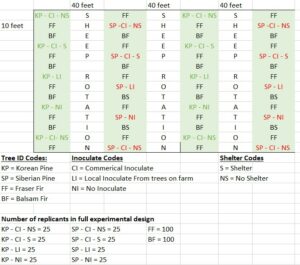Project Overview
Commodities
Practices
Proposal summary:
Trees that produce high value edible pine nuts have been costly
and difficult to establish and therefore, we will define
scientifically and communicate broadly, best practices for pine
nut tree establishment in the North Central Region.
Details: Edible pine nuts are a nutritious high value crop
that, once established, grows well on sandy soils in zones 2 or
greater. Therefore, pine nuts could be a good crop for farmers
looking to diversify revenue, sequester carbon, a establish a
multi-generational crop. However, there are no pine trees
native to the North Central Region that produce nuts large enough
to eat and as such, pine nut trees native to Asia, like Korean
Pine and Siberian Pine, need to be established. Because
Korean and Siberian Pine trees are not native to North America,
the symbiotic microbial environment they need to thrive may also
not be present and may limit establishment success.
Indeed, we had limited success (50% survival rate of 125
trees) establishing Korean Pine on our farm while plantings of
other species thrived. Here, we will test two types of soil
inoculates and one type of tree shelter to define best
establishment practices for pine nut trees in the North Central
Region.
Project objectives from proposal:
Objective: Determine how survival and growth of transplanted pine
nut trees vary with soil inoculate treatment and whether tree
shelters are used.
Solution: We will determine what establishment tactics produce
the highest survival and growth rates for two species of pine
that produce edible nuts in the North Central Region. We will
conduct the experiment on two types of trees that produce large
edible pine nuts and are hardy to Zone 3, Korean Pine and
Siberian Pine. We will vary inoculate treatments and tree shelter
treatments. The inoculate treatments will be a (1) commercially
available inoculate
(https://www.nuttrees.com/edible-nut-trees/edible-pine-nut-trees),
(2) inoculating with soil from under existing Korean Pine trees
on our property, and (3) no inoculate. Inoculate from existing
trees will be introduced by collecting 1 cup of dirt from under
our 6-year old Korean pines and placing the soil in the planting
hole. The trees shelter treatments will be a modified tree
shelter for evergreens that we will construct from mesh material.
The goal of the tree shelter is to provide some shade and
protection from wind, without producing the heat and confined
conditions of a typical tree tube. Therefore, the experimental
design will be a 2 x 3 x 2 factorial design (2 tree species, 3
inoculate treatments, 2 tree shelter treatments) with the
following number of replicates per treatment: 100 Korean pine; 50
with commercial inoculate, 25 with inoculate from existing Korean
Pine trees, and 25 with no inoculate. Of the 50 with commercial
inoculate, 25 will be a tree shelter and 25 will not be in a tree
shelter. The same number of Siberian Pine trees will be planted
with the same experimental treatment strategy. Treatments will be
randomized throughout the experimental planting. Pine nut trees
will be planted at a 30 foot by 40 foot spacing with drip
irrigation provided. As a control, two conifer trees native to
North America will be planted between the pine nut trees, namely
Fraser fir and balsam fir, so survival and growth of an industry
standard tree in the North Central Region can be compared to the
pine nut trees. Fraser and balsam fir are also a good companion
crop for pine nut trees because they can be harvested after 10
years for the wreath or Christmas tree industry as the pine nut
trees are maturing. Fir trees will be planted with the same
methods that the existing Christmas tree plantations on our farm
were established with 99% success. The entire experiment will
occur on a field with marginal hay production and loamy sand
soils; a circumstance common on many farms in the Midwest that
are on glacial till deposits. Soil tests will occur at the
beginning and end of the experiment. Potash will be applied
to the field prior to establishment. Sheep will be
grazed in the aisles of the planting (40 ft spacing) to keep the
land in production and soil nutrients cycling while the trees are
establishing. Results will be communicated through our website, a
conference presentation at the Midwest Nut Producers Council or
Savanna Institute Annual Meeting, a final report to SARE, and a
field day.
